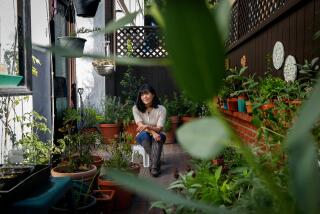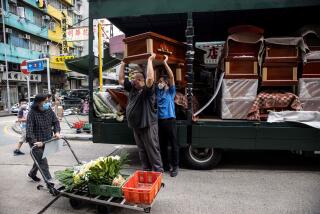Hong Kong Tries On the Green
HONG KONG â Every traveler builds imaginary cities. The Hong Kong of my dreams, constructed with the help of the films of Wong Kar-wai, John Woo and Jackie Chan, was a fantastic thicket of vertical concrete and intense street life.
I pictured it as a Blade Runner-like dystopia with Buck Rogers-style incline railways, moving walkways and trams--a skyscraper-spiked coastal rock hurtling from 19th century British colonialism toward millennial Chinese Communism.
It was gratifying, then, when I visited Hong Kong last October, to see that it wasnât all that different from my imaginings, though reality forced me to temper my mental picture with surprising splashes of green.
This densely populated city, with its striking clash of worldliness and wilderness, does seem addicted to futuristic transport. Its subway system is extensive and swift; a new bullet train links Hong Kong Island to Chek Lap Kok airport in just 23 minutes; minibuses dash office-tower denizens back to their hillside homes.
Thereâs even a system of outdoor escalators and raised walks that takes commuters from near sea level a half-mile up Victoria Peak to high-rise apartments with names like âWealthy Heights.â
From the escalatorâs upper tiers, itâs easy to get an overview of the cityâs geography. Skyscrapers crowd toward the waterfront of Central, the main commercial district on the north side of Hong Kong Island. Brand names emblazoned across the glass fronts there are a reminder that until 1997 this was an enclave of British free enterprise off the shores of Communist China.
Across choppy Victoria Harbor is the Kowloon Peninsula, on the Chinese mainland, also densely developed. Beyond Kowloon are the New Territories, the semirural buffer zone between mainland China and what the Chinese describe as the âSpecial Administrative Region of Hong Kong.â
Although Hong Kong Island was described by one of its British governors as a âbarren rock,â the towers of this high-tech human ant farm are surrounded by a countryside of verdant, bird-filled hills. And Hong Kong has been using this lush backdrop to promote itself as a green, environmentally friendly place.
Local officials like to emphasize that 40% of Hong Kongâs total area has been set aside for conservation, with 23 country parks and 14 special areas for wildlife and marine protection. There are 120 species of orchids growing here, 225 of butterflies and 445 of birds.
But Hong Kong as ecological haven? I eventually would come to appreciate the cityâs split personality, but my first reaction to this eco-tourism campaign was a snort of disbelief.
This is, after all, a city where smog and blistering heat killed three hikers in just one September day. Itâs a place where, no matter what the weather, the omnipresent air-conditioning seems set at a chilly 67 degrees--the perfect temperature, old Brits like to note, for tweed.
Then, too, there are constant reminders that in China, man sits atop the food chain.
In the streets of Kowloon, vendors sell swigs from bowls filled with a tonic decocted from boiled turtles. At Shia Wong Hip restaurant on Apliu Street, you can eat snake soup and sip cobra gallbladder wine while surrounded by cages of soon-to-be-slaughtered venomous serpents.
While pondering the tourist pitch for this place as ecological paradise, I paid an early evening visit to Kowloon Park, the central green space of the hotel and shopping district across the harbor from downtown Hong Kong.
Despite the bucolic promise of its name, the park, I soon realized, is made up almost entirely of concrete. It boasts a swimming pool, an aviary, a sculpture garden, a totem pole, an air-conditioned games hall and a McDonaldâs. But it is conspicuously lacking in greenery.
Yet when I hiked on the Dragonâs Back Trail, a ridge-top path on the central spine of Hong Kong Island, I was momentarily fooled into thinking I was in a tropical paradise. The skies were blue, the hillsides were full of squat rose myrtle bushes and bamboo and a strong breeze lofted hang gliders high above.
Hong Kong lies just south of the Tropic of Cancer, and on this October day, the islandâs sparsely populated eastern shore looked as idyllic as any coastal resort Iâve visited in the Mediterranean. With its white-walled one-story houses, Shek O, a town visible 500 yards below, could pass for a Greek fishing village.
The illusion of tropical splendor was almost complete--until I glanced over my shoulder. There I saw a thicket of skyscrapers sprouting between a nick in the green ridges behind me, and I recalled that millions of Hong Kong residents live in public housing blocks where, officials say, the average family unit measures a meager 500 square feet.
Meanwhile, the trail before me had descended to Shek O, where I enjoyed a cheap but tasty meal of shrimp curry at Chinese and Thailand Seafood Restaurant.
On another day I further explored Hong Kongâs âwilds,â as recommended to me by a British tour guide who specializes in Southeast Asiaâs environment. A morning trip to the Mai Po wetlands took me through the New Territories, the hinterland that, even today, is guarded to keep mainland Chinese from pouring into more affluent Hong Kong and exceeding the 150-people-a-day immigration limit.
The setting for this world-renowned bird sanctuary--run by a nonprofit environmental organization, the World Wide Fund for Nature--was inauspicious. Once rural, the New Territories now are filled with storage yards for ship containers and brand-new housing projects with such names as âPalm Springsâ and âMaple Gardens.â Peasant women in broad hats pick their way through auto body dumps.
The 940-acre nature reserve lies at the discharge of the polluted Shenzhen River, and its gei wais, the shrimp ponds that attract migrating birds, are regularly poisoned by effluent.
But the Mai Po wetlands also lie in what ornithologists call the East Asian flyway, and they provide wintering grounds for 70,000 birds, including, officials say, a quarter of the worldâs endangered black-faced spoonbills.
Although I tend to dismiss bird-watching as the biological equivalent of train spotting, I still found the Mai Po wetlands fascinating. A two-hour ramble through their well-marked trails turned up some herons, a few cormorants and many harriers and plovers loitering in the gei wais. But it was early in the season, and there was nothing rare or endangered to be seen.
I stopped at a shack where a young Nature Fund employee was putting an ID ring on the leg of a common kingfisher.
After tagging the bird, he set it with its back down in my palm, and I felt its heart beating like a stopwatch. The tiny bird righted itself, swiveled its iridescent head almost 360 degrees--an avian Linda Blair exorcising the demons of human contact--and flitted away.
I walked on and soon came to a tall chain-link fence topped with razor wire, intended to keep out border crossers. But there was a gate, which opened onto a creaking, floating boardwalk. It cut through a mangrove swamp, silent except for the eerie clicking of fiddler crabs with single, enlarged Popeye-style pincers.
Farther down this path was a spacious bird-watching blind that looked out over Deep Bay. Beyond the blind, the tide was far out, and the few birds on hand were outnumbered by mudskippers, primitive fish with bulbous eyes that can live out of the water for long periods of time.
Millions of them wallowed in the mud, executing pointless little leaps into the air. I got the depressing feeling that I was glimpsing my earliest ancestor, an unambitious relative that decided the intertidal zone was as far as it wanted to venture outside the primal ocean. Perhaps, given local voraciousness, the mudskipper was wise to remain unevolved, ugly and inedible.
Back in the city, at the goldfish market on Kowloonâs Tung Choi Street, I noticed that a moribund little specimen had been tossed onto the sewer grate by a cavalier shop owner.
I took a short walk to the Yuen Po Street Bird Garden, where, in contrast, I saw what looked like genuine appreciation for animals: Old men carrying small bamboo cages sat on benches, cooing and whispering to their songbirds. It was somewhat embarrassing, as though Iâd wandered into a park full of lovers.
Older men in Hong Kong, Iâve been told, sometimes prefer their birds to their wives, and the attentions being lavished on these pampered creatures seemed to bear this out.
A middle-aged man in an Adidas shirt directed a hose at a cage, offering his tiny green parrot a cooling shower. He then reached into a bag, pulled out a live grasshopper and deftly slit its abdomen with a razor blade. He paper-clipped the writhing insect to the cage. An onlooker said, appreciatively, âThat is like a steak meal for the parrot.â Itâs this kind of idiosyncratic sensibility--much more than the proximity of nature--that makes me appreciate Hong Kong.
Indeed, a satisfying visit to this endlessly fascinating city involves finding a balance between its intense urbanity and its natural wonders. It is amazing, after all, that in this megalopolis, pink dolphins still thrive in the waters near the bustling airport; bands of macaques still startle executives jogging around Kowloon Reservoir; and 6.4 million human inhabitants manage to stay off the endangered species list.
(BEGIN TEXT OF INFOBOX / INFOGRAPHIC)
GUIDEBOOK
Getting a Handle on Hong Kong
Getting there: Cathay Pacific and United offer nonstop service from LAX. Restricted round-trip fares begin at $815.
Where to stay: I stayed at the Shamrock Hotel, 223 Nathan Road, telephone 011-852-2735-2271, fax 011-852-2405-0922, Internet https://www.asiatravel.com/shamrock, a cheap but clean hotel in the heart of Kowloon. Doubles begin at $62. In an altogether different class is the Kowloon Shangri-La, 64 Mody Road, tel. 011-852-2721-2111, fax 011-852-2723-8686, Internet https://www.shangri-la.com. It has spectacular views of the harbor, several restaurants and some of the largest suites in the city. Rooms begin at $230.
Where to eat: Shia Wong Hip restaurant, a compact eatery at 170 Apliu St. in Kowloon, local tel. 2386-9064, serves a deliciously spicy soup made from snakes displayed in cages piled to the ceilings, and shots of brandy. A cheap, old-fashioned cafe in Kowloon is the Peking, 227 Nathan Road, tel. 2730-1315, whose wooden walls and tasseled lanterns make for an atmospheric eating experience. Its specialty is Peking duck, served with small pancakes, green onions, cucumbers and plum sauce; average $20.
Getting around: The Airport Express Line, a high-tech bullet train that whisks new arrivals from Chek Lap Kok airport to Kowloon and Hong Kong Island at speeds of up to 85 mph, is a comfortable way to reach the city. Television screens set into the seat backs give current information on flight departure and arrival times. One-way adult fare is about $9. The Mass Transit Railway is a convenient subway system linking Kowloon to Hong Kong Island; the maximum one-way fare is about $3.35. Taxis are best hailed at stands outside major hotels. Red taxis serve the Hong Kong area; blue cabs go to Lantau Island (and the airport); and green taxis serve the New Territories on the Chinese mainland. The meter starts about $2 and jumps about 20 cents for every 200 yards.
For more information: The Hong Kong Tourist Assn., 10940 Wilshire Blvd., Suite 2050, Los Angeles, CA 90024; tel. (800) 282-HKTA (282-4582) or (310) 208-4582, fax (310) 208-1869, Internet https://www.hkta.org.
More to Read
Sign up for Essential California
The most important California stories and recommendations in your inbox every morning.
You may occasionally receive promotional content from the Los Angeles Times.










